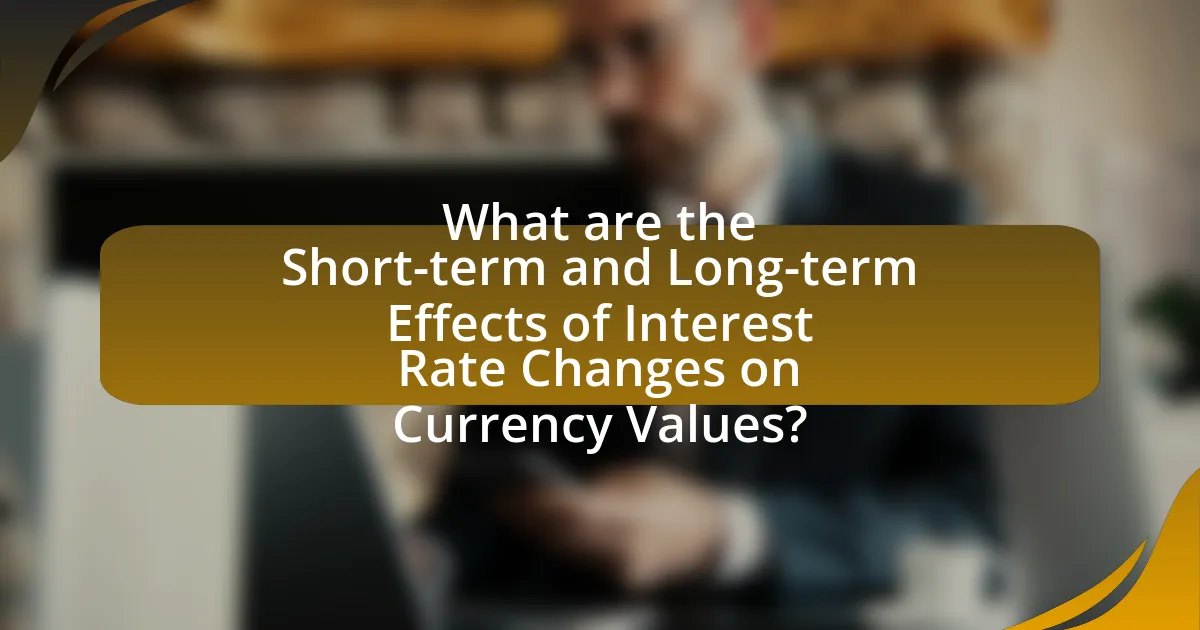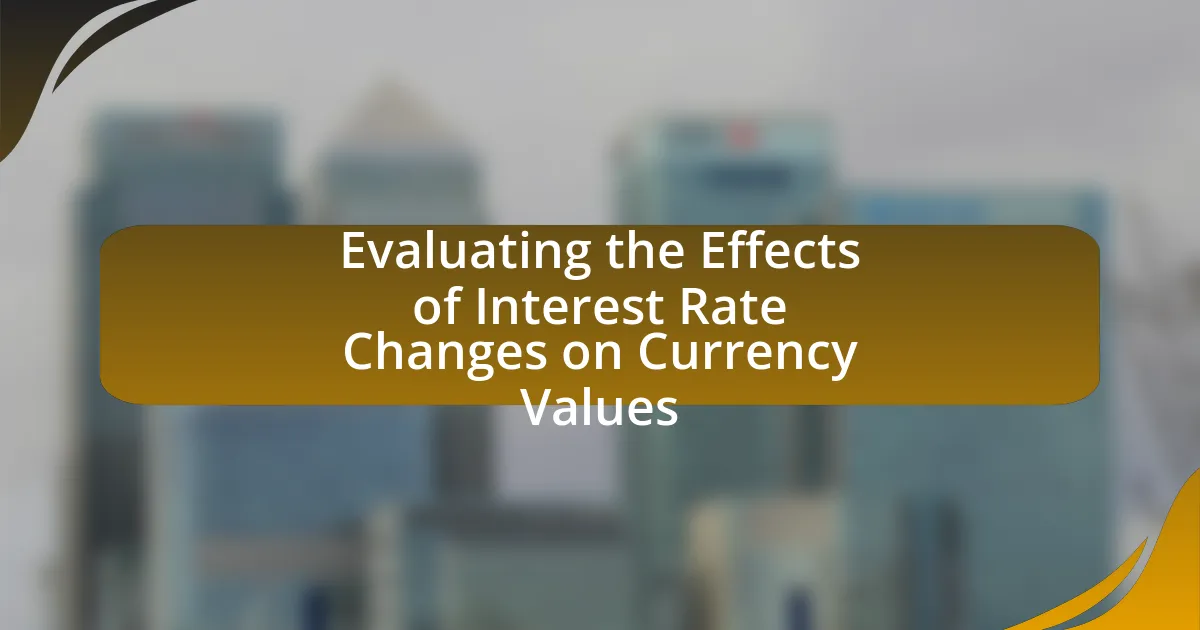The article evaluates the effects of interest rate changes on currency values, highlighting the mechanisms through which interest rates influence capital flows and investor sentiment. It discusses how rising interest rates typically lead to currency appreciation due to increased foreign investment, while lower rates can result in depreciation. Key concepts such as interest rate parity theory, market expectations, and the role of central banks in adjusting rates are examined, along with historical examples illustrating these dynamics. The article also addresses the short-term and long-term implications of interest rate changes on currency values, providing insights into strategies investors can use to navigate currency markets affected by these fluctuations.

What are the Effects of Interest Rate Changes on Currency Values?
Interest rate changes significantly impact currency values, primarily through their influence on capital flows and investor sentiment. When a country’s central bank raises interest rates, it typically attracts foreign capital as investors seek higher returns, leading to an appreciation of that country’s currency. For example, following the U.S. Federal Reserve’s interest rate hikes in 2015, the U.S. dollar strengthened against other currencies, reflecting increased foreign investment in U.S. assets. Conversely, when interest rates are lowered, capital may flow out, resulting in currency depreciation. This relationship is supported by the interest rate parity theory, which posits that differences in interest rates between countries will be reflected in the exchange rates.
How do interest rates influence currency exchange rates?
Interest rates significantly influence currency exchange rates by affecting capital flows and investor behavior. When a country’s interest rates rise, it typically attracts foreign capital as investors seek higher returns, leading to an appreciation of that country’s currency. For example, in 2015, when the U.S. Federal Reserve raised interest rates, the U.S. dollar strengthened against other currencies, reflecting increased investment in U.S. assets. Conversely, lower interest rates can lead to depreciation, as seen in Japan, where prolonged low rates have contributed to a weaker yen. This relationship is supported by the interest rate parity theory, which states that differences in interest rates between countries will be reflected in the exchange rates.
What mechanisms link interest rates to currency valuation?
Interest rates influence currency valuation primarily through the mechanisms of capital flows, inflation expectations, and interest rate differentials. Higher interest rates attract foreign capital, as investors seek better returns, leading to increased demand for the currency and appreciation in its value. For example, when the U.S. Federal Reserve raises interest rates, it often results in a stronger U.S. dollar due to increased foreign investment. Additionally, higher interest rates can signal lower inflation expectations, which further supports currency strength. Conversely, lower interest rates may lead to depreciation as capital flows out in search of higher yields elsewhere. Historical data shows that during the 2015-2018 period, the U.S. dollar strengthened significantly as the Federal Reserve increased rates, demonstrating the direct link between interest rates and currency valuation.
How do market expectations about interest rates affect currency values?
Market expectations about interest rates significantly influence currency values, as higher anticipated interest rates typically lead to an appreciation of a currency. This occurs because higher interest rates offer better returns on investments denominated in that currency, attracting foreign capital. For instance, when the U.S. Federal Reserve signals an increase in interest rates, the U.S. dollar often strengthens against other currencies, as seen in historical trends where the dollar rose following rate hike announcements. Additionally, according to a study by the International Monetary Fund, a 1% increase in interest rates can lead to a 2-3% appreciation in the currency value, demonstrating the direct correlation between interest rate expectations and currency strength.
Why do central banks adjust interest rates?
Central banks adjust interest rates primarily to control inflation and stabilize the economy. By increasing interest rates, central banks can reduce consumer spending and borrowing, which helps to lower inflation. Conversely, lowering interest rates encourages borrowing and spending, stimulating economic growth. For example, the Federal Reserve raised interest rates multiple times in 2022 to combat rising inflation, which reached a 40-year high. This adjustment directly influences currency values, as higher interest rates typically attract foreign investment, leading to an appreciation of the currency.
What economic indicators influence central bank decisions on interest rates?
Central banks make interest rate decisions based on several key economic indicators, including inflation rates, unemployment rates, GDP growth, and consumer spending. Inflation rates are critical as central banks aim to maintain price stability; for instance, a rising inflation rate may prompt a central bank to increase interest rates to cool down the economy. Unemployment rates provide insight into labor market conditions; a low unemployment rate may lead to higher wages and spending, influencing rate hikes. GDP growth reflects the overall economic health; strong growth can lead to increased interest rates to prevent overheating. Consumer spending is also vital, as higher spending can signal economic strength, prompting central banks to adjust rates accordingly. These indicators collectively guide central banks in their monetary policy to achieve economic stability and growth.
How do interest rate changes reflect economic conditions?
Interest rate changes reflect economic conditions by indicating the central bank’s response to inflation and economic growth. When a central bank raises interest rates, it typically signals an attempt to curb inflation, suggesting that the economy is growing too quickly. Conversely, lowering interest rates often indicates a need to stimulate economic activity during periods of slow growth or recession. For example, the Federal Reserve increased rates multiple times in 2018 to combat rising inflation, reflecting a robust economy, while the rate cuts in 2020 in response to the COVID-19 pandemic illustrated efforts to support a struggling economy. These actions directly influence currency values, as higher interest rates can attract foreign investment, increasing demand for the currency, while lower rates may lead to depreciation.
What historical examples illustrate the impact of interest rate changes on currencies?
Interest rate changes have historically had significant impacts on currency values, with notable examples including the U.S. Federal Reserve’s actions in the early 1980s and the European Central Bank’s decisions during the Eurozone crisis. In the early 1980s, the Federal Reserve raised interest rates to combat inflation, resulting in a strong U.S. dollar, which appreciated significantly against other currencies, such as the Japanese yen and the British pound. This period saw the dollar reach its highest value in over a decade, illustrating how higher interest rates can attract foreign investment and increase demand for a currency.
Similarly, during the Eurozone crisis in 2011, the European Central Bank’s decision to lower interest rates in response to economic instability led to a depreciation of the euro against the U.S. dollar. As interest rates fell, investors sought higher returns elsewhere, resulting in reduced demand for the euro. These historical instances demonstrate the direct correlation between interest rate adjustments and currency fluctuations, supported by the observable changes in exchange rates during those periods.
How did the 2008 financial crisis affect interest rates and currency values?
The 2008 financial crisis led to a significant decrease in interest rates and a fluctuation in currency values. Central banks, particularly the Federal Reserve, responded to the crisis by slashing interest rates to near-zero levels to stimulate economic activity, with the Federal Funds Rate dropping from 5.25% in 2007 to a target range of 0% to 0.25% by December 2008. This drastic reduction in interest rates made borrowing cheaper, but it also weakened the U.S. dollar as lower rates typically reduce the attractiveness of a currency to foreign investors. Consequently, the dollar depreciated against other currencies, with the Euro rising from approximately 1.45 USD in early 2008 to around 1.60 USD by mid-2008, reflecting the impact of the crisis on currency values.
What lessons can be learned from past interest rate adjustments?
Past interest rate adjustments demonstrate that changes in rates significantly influence currency values. For instance, when the Federal Reserve raised interest rates in December 2015, the U.S. dollar strengthened against other currencies, reflecting increased investor confidence and capital inflows. Conversely, the European Central Bank’s rate cuts in 2016 led to a depreciation of the euro, as lower rates typically reduce the attractiveness of a currency for investors seeking higher returns. These historical examples illustrate that interest rate hikes generally bolster a currency’s value, while cuts tend to weaken it, emphasizing the critical relationship between monetary policy and currency strength.

What are the Short-term and Long-term Effects of Interest Rate Changes on Currency Values?
Short-term effects of interest rate changes on currency values typically involve immediate fluctuations in exchange rates, as higher interest rates attract foreign capital, leading to currency appreciation. For instance, when the Federal Reserve raises interest rates, the U.S. dollar often strengthens against other currencies due to increased demand from investors seeking higher returns.
Long-term effects, however, can be more complex. Sustained higher interest rates may lead to slower economic growth, which can eventually weaken a currency if it results in reduced consumer spending and investment. Historical data shows that countries with consistently high interest rates, like Brazil in the early 2000s, experienced currency appreciation initially, but long-term economic challenges led to depreciation as growth slowed.
Thus, while short-term effects are characterized by immediate currency appreciation due to capital inflows, long-term effects can involve depreciation if high rates hinder economic growth.
How do short-term interest rate changes impact currency values?
Short-term interest rate changes significantly impact currency values by influencing capital flows and investor sentiment. When a central bank raises short-term interest rates, it typically attracts foreign capital as investors seek higher returns, leading to an appreciation of the currency. For example, following the Federal Reserve’s rate hikes in 2015, the U.S. dollar strengthened against other currencies due to increased foreign investment. Conversely, when rates are lowered, capital may flow out, resulting in currency depreciation. Historical data shows that a 1% increase in interest rates can lead to a 2-3% appreciation in currency value within a few months, illustrating the direct correlation between interest rates and currency strength.
What immediate market reactions occur following interest rate announcements?
Immediate market reactions following interest rate announcements typically include fluctuations in stock prices, bond yields, and currency values. For instance, when a central bank raises interest rates, stock markets often react negatively due to anticipated higher borrowing costs, while bond yields may increase as investors demand higher returns. Additionally, the currency of the country that raised rates usually appreciates against other currencies, reflecting increased investor confidence and capital inflows. Historical data shows that after the Federal Reserve’s interest rate hikes, the U.S. dollar often strengthens, as seen in the 2015 rate increase when the dollar rose significantly against major currencies.
How do traders respond to short-term interest rate fluctuations?
Traders respond to short-term interest rate fluctuations by adjusting their positions in financial markets, often leading to increased volatility in currency values. When short-term interest rates rise, traders typically anticipate higher returns on investments denominated in that currency, prompting them to buy that currency, which strengthens its value. Conversely, when rates fall, traders may sell off that currency in favor of others with higher yields, leading to depreciation. Historical data shows that during the Federal Reserve’s rate hikes in 2015, the U.S. dollar appreciated significantly against other currencies, illustrating how traders react to such changes.
What are the long-term implications of sustained interest rate changes on currency values?
Sustained interest rate changes significantly impact currency values over the long term by influencing capital flows and inflation expectations. When a country raises interest rates, it typically attracts foreign investment, leading to an appreciation of its currency due to increased demand. For instance, the U.S. Federal Reserve’s interest rate hikes from 2015 to 2018 resulted in a stronger U.S. dollar as investors sought higher returns. Conversely, prolonged low interest rates can lead to currency depreciation as capital flows out in search of better yields elsewhere, exemplified by Japan’s low rates contributing to a weaker yen over decades. Additionally, sustained interest rate changes can alter inflation expectations; higher rates often signal a commitment to controlling inflation, which can bolster currency strength, while lower rates may raise concerns about future inflation, weakening the currency.
How do prolonged interest rate changes affect investor confidence?
Prolonged interest rate changes significantly affect investor confidence by altering perceptions of economic stability and growth potential. When interest rates remain high for an extended period, investors may perceive increased borrowing costs and reduced consumer spending, leading to concerns about economic slowdown. For instance, during the period of rising interest rates from 2015 to 2018 in the United States, investor confidence fluctuated as the Federal Reserve increased rates, impacting stock market performance and investment decisions. Conversely, sustained low interest rates can boost investor confidence by encouraging borrowing and spending, as seen in the post-2008 financial crisis era, where low rates supported economic recovery and increased market participation. Thus, the relationship between prolonged interest rate changes and investor confidence is closely tied to economic outlook and market dynamics.
What role does inflation play in the long-term effects of interest rate changes?
Inflation significantly influences the long-term effects of interest rate changes by affecting real interest rates and purchasing power. When central banks raise interest rates to combat inflation, the nominal interest rates increase, but if inflation remains high, the real interest rates may not rise as much, leading to diminished returns on savings and investments. For instance, if the nominal interest rate is 5% and inflation is 3%, the real interest rate is only 2%. Over time, persistent inflation can erode the effectiveness of interest rate hikes, as seen in historical contexts like the 1970s stagflation in the United States, where high inflation persisted despite rising interest rates, ultimately leading to economic stagnation. Thus, inflation plays a crucial role in determining the effectiveness and consequences of interest rate adjustments on economic stability and currency values.
How do different currencies react to interest rate changes in major economies?
Different currencies typically appreciate or depreciate in response to interest rate changes in major economies, reflecting investor sentiment and capital flows. When a central bank raises interest rates, the currency of that economy often strengthens due to higher returns on investments denominated in that currency, attracting foreign capital. For instance, following the U.S. Federal Reserve’s interest rate hikes in 2015, the U.S. dollar appreciated significantly against other currencies, as investors sought higher yields. Conversely, when interest rates are lowered, currencies may weaken as capital flows out in search of better returns elsewhere. Historical data shows that the Euro depreciated against the dollar during periods of European Central Bank rate cuts, as seen in 2016. Thus, interest rate changes are a critical factor influencing currency values in major economies.
What patterns emerge in currency values following interest rate changes in the US?
Currency values typically appreciate following interest rate increases in the US, as higher rates attract foreign investment seeking better returns. For instance, after the Federal Reserve raised interest rates in December 2015, the US dollar strengthened against major currencies, reflecting increased demand for dollar-denominated assets. Conversely, when interest rates are lowered, currency values often depreciate due to reduced yields, as seen in the aftermath of rate cuts in 2008 during the financial crisis, which led to a weaker dollar. Historical data supports these trends, showing a correlation between interest rate adjustments and currency fluctuations, with the dollar often moving in the opposite direction of interest rate changes.
How do interest rate changes in emerging markets affect their currencies?
Interest rate changes in emerging markets significantly influence their currencies by affecting capital flows and investor sentiment. When a central bank in an emerging market raises interest rates, it typically attracts foreign investment seeking higher returns, leading to an appreciation of the local currency. For example, Brazil’s central bank raised interest rates in 2015, resulting in a stronger Brazilian real as foreign investors sought higher yields. Conversely, when interest rates are lowered, capital may flow out of the country, causing the currency to depreciate. This relationship is supported by the interest rate parity theory, which suggests that differences in interest rates between countries will lead to adjustments in exchange rates to maintain equilibrium.

What Strategies Can Investors Use to Navigate Currency Markets Affected by Interest Rate Changes?
Investors can navigate currency markets affected by interest rate changes by employing strategies such as hedging, diversification, and utilizing interest rate differentials. Hedging involves using financial instruments like options and futures to protect against adverse currency movements, which is crucial when interest rates fluctuate, as they can significantly impact currency values. Diversification across various currencies can mitigate risks associated with specific currency volatility due to interest rate changes. Additionally, investors can capitalize on interest rate differentials by investing in currencies with higher interest rates, as these tend to appreciate relative to currencies with lower rates. Historical data shows that currencies of countries with rising interest rates often strengthen, providing a clear rationale for these strategies.
How can investors anticipate currency movements based on interest rate trends?
Investors can anticipate currency movements based on interest rate trends by analyzing the relationship between interest rates and currency value fluctuations. When a country’s central bank raises interest rates, it typically attracts foreign capital, leading to an appreciation of that country’s currency. For example, following the U.S. Federal Reserve’s interest rate hikes in 2015, the U.S. dollar strengthened significantly against other currencies, reflecting increased investor confidence and capital inflow. Conversely, when interest rates are lowered, capital may flow out, resulting in currency depreciation. Historical data shows that a 1% increase in interest rates can lead to a 2-3% appreciation in currency value within a few months, illustrating the strong correlation between interest rate changes and currency movements.
What tools and indicators can help predict currency reactions to interest rate changes?
Tools and indicators that can help predict currency reactions to interest rate changes include interest rate differentials, economic indicators, and market sentiment analysis. Interest rate differentials, which compare the interest rates of two currencies, directly influence currency value; for example, if the U.S. Federal Reserve raises interest rates while the European Central Bank maintains lower rates, the U.S. dollar typically strengthens against the euro. Economic indicators such as GDP growth, inflation rates, and employment data provide context for interest rate decisions and can signal potential currency movements; for instance, strong employment data may lead to expectations of rate hikes, impacting currency strength. Market sentiment analysis, often gauged through tools like the Commitment of Traders report or sentiment indices, reflects trader positioning and can indicate potential currency reactions to anticipated interest rate changes.
How can diversification mitigate risks associated with currency fluctuations?
Diversification can mitigate risks associated with currency fluctuations by spreading investments across multiple currencies and asset classes, thereby reducing exposure to any single currency’s volatility. When an investor holds assets in various currencies, the negative impact of a decline in one currency can be offset by stability or gains in others. For instance, during periods of economic instability, currencies may react differently; if one currency depreciates, another may appreciate, balancing the overall portfolio performance. Historical data shows that diversified portfolios tend to exhibit lower volatility compared to concentrated investments, as evidenced by studies indicating that a well-diversified portfolio can reduce risk by up to 30% compared to a non-diversified one.
What are the best practices for trading currencies in response to interest rate changes?
The best practices for trading currencies in response to interest rate changes include closely monitoring central bank announcements, analyzing economic indicators, and employing risk management strategies. Traders should pay attention to interest rate decisions from central banks, as these can significantly influence currency values; for instance, a rate hike typically strengthens a currency due to higher returns on investments denominated in that currency. Additionally, analyzing economic indicators such as inflation rates and employment data can provide insights into potential interest rate movements. Implementing risk management strategies, such as setting stop-loss orders and diversifying currency pairs, helps mitigate potential losses during volatile market conditions. Historical data shows that currencies often react sharply to interest rate changes, making these practices essential for effective trading.
How should investors adjust their portfolios during interest rate hikes or cuts?
Investors should adjust their portfolios by reallocating assets towards sectors that typically benefit from interest rate changes during hikes or cuts. For instance, during interest rate hikes, investors often shift towards financial stocks, as banks can earn more from higher interest rates, while reducing exposure to interest-sensitive sectors like utilities and real estate, which may suffer from increased borrowing costs. Conversely, during interest rate cuts, investors may favor growth stocks and sectors like consumer discretionary, as lower rates can stimulate spending and borrowing. Historical data shows that in the 2004-2006 rate hike cycle, financial stocks outperformed the market, while utilities lagged, illustrating the impact of interest rate changes on sector performance.
What common mistakes should investors avoid when trading currencies based on interest rates?
Investors should avoid overreacting to interest rate announcements, as this can lead to impulsive trading decisions. Many traders mistakenly assume that a single rate change will have an immediate and significant impact on currency values, ignoring the broader economic context and market sentiment. For example, the U.S. Federal Reserve’s interest rate hikes in 2015 did not lead to a straightforward appreciation of the dollar, as other economic factors, such as global growth and geopolitical risks, also influenced currency movements. Additionally, investors often fail to consider the lag effect of interest rate changes on the economy, which can take months to manifest in currency valuations. This oversight can result in premature trades that do not align with the longer-term market trends.
What resources are available for staying informed about interest rate changes and currency values?
Financial news websites, central bank announcements, and economic data platforms are key resources for staying informed about interest rate changes and currency values. Websites like Bloomberg and Reuters provide real-time updates on interest rates and currency fluctuations. Central banks, such as the Federal Reserve and the European Central Bank, publish official statements and reports that detail interest rate decisions and economic outlooks. Additionally, platforms like Trading Economics and Investing.com offer comprehensive economic calendars that track upcoming interest rate announcements and historical currency data, ensuring users have access to timely and relevant information.
How can economic calendars assist investors in tracking interest rate announcements?
Economic calendars assist investors in tracking interest rate announcements by providing scheduled dates and times for these events, along with relevant economic indicators. These calendars list central bank meetings, where interest rate decisions are made, allowing investors to anticipate market movements based on expected changes. For instance, the Federal Reserve’s interest rate announcements can significantly impact the U.S. dollar’s value; thus, knowing the exact timing helps investors position their trades effectively. Historical data shows that currency pairs often experience volatility around these announcements, reinforcing the importance of economic calendars in strategic planning for currency trading.
What role do financial news outlets play in providing insights on currency and interest rates?
Financial news outlets play a crucial role in providing insights on currency and interest rates by delivering timely information and analysis that influences market perceptions and investor behavior. These outlets report on economic indicators, central bank policies, and geopolitical events that directly impact currency valuations and interest rate movements. For instance, when the Federal Reserve announces a change in interest rates, financial news outlets disseminate this information rapidly, allowing traders and investors to adjust their strategies accordingly. Research indicates that news coverage can significantly affect currency exchange rates, as seen during the 2008 financial crisis when media reports influenced market sentiment and trading volumes. Thus, financial news outlets serve as vital intermediaries that shape understanding and reactions to fluctuations in currency and interest rates.
